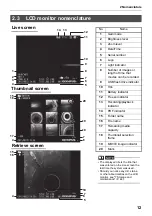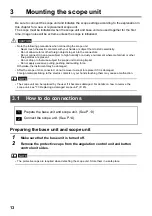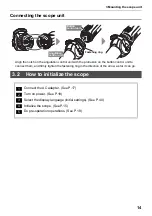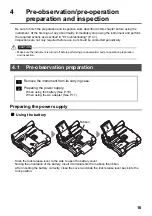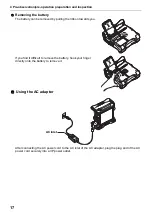
3
•
To ensure electrical safety, connect the power cord to a 3P power outlet.
Electrical safety designed into the product by Olympus cannot be guaranteed if there is no
connection to power outlet ground.
•
Do not unplug the power cord while the system is on.
•
Do not use the AC adapter outdoors.
Otherwise, electric shock might occur, or smoke emission and fire might occur, causing damage
to the instrument.
The AC adapter is designed for indoor use.
•
Do not subject the AC adapter to strong impact such as by striking it against a wall, dropping it,
etc.
Otherwise, malfunction, damage, or electric shock might occur.
•
Do not connect the AC power cord to power outlets having a different rating.
The AC power cord is exclusively for 100 to 120 V AC (50/60 Hz) power. Connecting the AC
power cord to a power outlet having a different rating may lead to fire or electric shock.
•
Always grasp the plug when unplugging it from the electric outlet.
Pulling the cord creates the risk of wire breakage and other malfunction.
•
Do not leave the distal end illumination on.
Otherwise, the illumination emitted from the distal end may heat up a nearby object and cause it
to ignite. Whenever stopping operation, be sure to turn off illumination.
•
Do not look directly into the illumination being emitted by the distal end.
Otherwise, eye damage may result.
•
Do not expose the LCD monitor to strong impact, strong pressure, or to scratching by a hard or
pointed object.
Otherwise, the LCD monitor might be cracked or scratched, or a damaged monitor could create
the risk of personal injury.
•
Do not subject the insertion tube or other cables to strong pulling, and do not move the main unit
around by holding the cables.
Otherwise, the insertion tube and/or cables may be damaged. Also, the operator may fall over
when the shoulder belt is used.
•
Do not allow any liquids other than water, saltwater, machine oil, or diesel oil to come into
contact with the insertion tube.
Otherwise, the insertion tube may be damaged.
•
Do not allow water to come into contact with parts other than the insertion tube.
Water creates the risk of electric shock. The parts of the instrument other than the insertion tube,
including the carrying case, are not watertight, so the instrument should not be used or stored
where it is submerged or wet.
•
Do not subject the distal end to dropping, impact or pulling, and do not expose the angulation
section to severe impact or bending.
Otherwise, the precision components that make up the distal end and the angulation section
might be damaged.
•
Do not touch the distal end of the insertion tube immediately after using it in a very hot
environment.
The distal end of the insertion tube is hot immediately after it is used in a very hot environment.
Touching it may result in burns.
•
Note the following precautions whenever operating the angulation section.
•
Do not bend the insertion tube to a radius that is less than its minimum bend radius of 20 mm.
•
Should you sense any abnormality when performing angulation operation, do not try to force
the angulation operation.
Doing so can damage the insertion tube or observation object.
•
Never use an insertion tube when any of its parts are loose.
Doing so creates the risk of loose parts falling off during use.
Summary of Contents for IPLEX TX
Page 1: ...INSTRUCTIONS INDUSTRIAL VIDEOSCOPE IPLEX TX ...
Page 3: ......

















